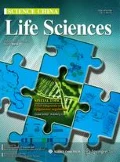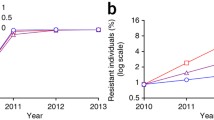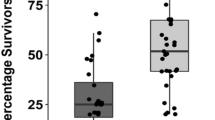Abstract
In the context of genetically modified crops expressing the Bacillus thuringiensis (Bt) toxin, a ‘refuge’ refers to a crop of the same or a related species that is planted nearby to enable growth and reproduction of the target pest without the selection pressure imposed by the Bt toxin. The goal of this study is to discuss the role of natural refuge crops in slowing down the buildup of resistance of cotton bollworm (CBW), and to evaluate China’s no-refuge policy for Bt cotton. We describe in detail the different factors that China should consider in relation to the refuge policy. Drawing on a review of scientific data, economic analyses of other cases, and a simulation exercise using a bio-economic model, we show that in the case of Bt cotton in China, the no-refuge policy is defensible.
Similar content being viewed by others
References
Tabashnik B E, Carrière Y, Dennehy T J, et al. Insect resistance to transgenic Bt crops: lessons from the laboratory and field. J Econ Entomol, 2003, 96: 1031–1038, 1:CAS:528:DC%2BD3sXns1Kgurs%3D, 10.1603/0022-0493-96.4.1031, 14503572
Heckel D G, Gahan L J, Baxter S W, et al. The diversity of Bt resistance genes in species of Lepidoptera. J Invertebr Pathol, 2007, 95: 192–197, 1:CAS:528:DC%2BD2sXmvVOntrs%3D, 10.1016/j.jip.2007.03.008, 17482643
Gao Y, Wu K, Gould F. Frequency of Bt resistance alleles in H. armigera during 2006–2008 in northern China. Environ Entomol, 2009, 38: 1336–1342, 10.1603/022.038.0445, 19689916
Wu K M, Guo Y Y. Evolution of cotton pest management practice in China. Annu Rev Entomol, 2005, 50: 31–52, 1:CAS:528:DC%2BD2MXhtFOqt7w%3D, 10.1146/annurev.ento.50.071803.130349, 15355239
Banerjee S, Martin S. An estimation of producer returns from Bt cotton with varying refuge sizes. Crop Prot, 2008, 27: 1003–1008, 10.1016/j.cropro.2007.12.008
United States Environmental Protection Agency. Pesticide news story: EPA approves natural refuge for insect resistance management in Bollgard II cotton. June 4, 2007. http://www.epa.gov/oppfead1/cb/csb_page/updates/2007/bollgard-cotton.htm
Bagla P. Hardy cotton-munching pests are latest blow to GM crops. Science, 2010, 19: 1439, 10.1126/science.327.5972.1439
Tabashnik B E, Van Rensburg J B J, Carrière Y. Field-evolved insect resistance to Bt crops: definition, theory, and data, J Econ Entomol, 2009, 102: 2011–2025, 1:CAS:528:DC%2BD1MXhs1SjtrvK, 10.1603/029.102.0601, 20069826
Liu F Y, Xu Z P, Chang J H, et al. Resistance allele frequency to Bt cotton in field populations of Helicoverpa armigera (Lepidoptera: Noctuidae) in China. J Econ Entomol, 2008, 101: 933–943, 1:CAS:528:DC%2BD1cXosVWqtro%3D, 10.1603/0022-0493(2008)101[933:RAFTBC]2.0.CO;2, 18613597
Pingali P L, Hossain M, Gerpacio R V. Asian Rice Bowls: The Returning Crisis? Oxon: CAB International for the International Rice Research Institute, 1997
Hsu H, Gale F. Regional shifts in China’s cotton production and use. In: Cotton and Wool Situation and Outlook. Washington DC: Economic Research Service, USDA, 2001
Huang J K, Hu R F, Rozelle S D, et al. Small holders, transgenic varieties, and production efficiency: the case of cotton farmers in China. Aust J Agr Resour Ec, 2002, 46: 367–387, 10.1111/1467-8489.00184
Huang J K, Rozelle S D, Pray C E, et al. Plant biotechnology in China. Science, 2002, 295: 674–677, 1:CAS:528:DC%2BD38XptF2ktw%3D%3D, 10.1126/science.1067226, 11809972
Hossain F, Pray C E, Lu Y M, et al. Genetically modified cotton and farmers’ health in China. Int J Environ Health Res, 2004, 10: 296–303, 1:CAS:528:DC%2BD2cXot1agsLg%3D
Zhang Y S, Xu F. The primary research on remain of BHC in the soil of rice field in Zhujiang Delta. Agro-Environmental Protection (in Chinese), 1989, 1: 4–9
Xiong W L, Chen Y B. Review of effect of pesticide leaching into groundwater. Southwest China Journal of Agricultural Sciences (in Chinese), 2003, S1: 43–48
Guo Y Y. Research on Cotton Bollworm. Beijing: China Agricultural Press, 1998
Stone B. Agricultural technology in China. China Quarterly, 1988, 116: 767–822, 10.1017/S0305741000037954
Stone B. Basic agricultural technology under reform. In: Yuch Y Y, Ash R F, eds. Economic Trends in Chinese Agriculture: The Impact of Post-Mao Reforms. Oxford: Clarendon Press, 1993
Widawsky D, Rozelle S D, Jin S Q, et al. Pesticide productivity, host-plant resistance and productivity in China. Agricultural Economics, 1998, 19: 203–217, 10.1016/S0169-5150(98)00049-8
Wu K M, Wu W, Liang G M, et al. Regional reversion of insecticide resistance in Helicoverpa armigera (Lepidoptera: Noctuidae) is associated with the use of Bt cotton in northern China. Pest Manage Science, 2004, 61: 491–498, 10.1002/ps.999
Gouse M, Pray C E, Schimmelpfennig D. The distribution of benefits from Bt cotton adoption in South Africa. AgBioForum, 2004, 7: 187–194
Huang J K, Hu R F, van Meijl H, et al. Biotechnology boosts to crop productivity in China: trade and welfare implications. Journal of Development Economics, 2004, 75: 27–54, 10.1016/j.jdeveco.2003.07.005
Pray C E, Ma D M, Huang J K, et al. Impact of Bt cotton in China. World Development, 2001, 29: 813–825, 10.1016/S0305-750X(01)00010-9
Qaim M, Zilberman D. Yield effects of genetically modified crops in developing countries. Science, 2003, 299: 900–902, 1:CAS:528:DC%2BD3sXpt1SgsA%3D%3D, 10.1126/science.1080609, 12574633
Traxler G, Godoy-Avila S, Falck-Zepeda J, et al. Transgenic cotton in Mexico: economic and environmental impacts (unpublished report). Auburn, AL: Department of Agricultural Economics, Auburn University, 2001
Pray C E, Huang J K, Rozelle S D. Five years of Bt cotton production in China: the benefits continue. The Plant Journal, 2002, 31: 423–430, 1:CAS:528:DC%2BD38XnvVSqt74%3D, 10.1046/j.1365-313X.2002.01401.x, 12182701
Huang J K, Hai L, Hu R F, et al. Eight years of Bt cotton in farmer fields in China: has the bollworm population developed resistance? Working paper, Center for Chinese Agricultural Policy of Chinese Academy of Sciences. Beijing, China, 2006
Bates S L, Zhao J, Roush R T, et al. Insect resistance management in GM crops: past, present and future. Nature Biotechnology, 2005, 23: 57–62, 1:CAS:528:DC%2BD2MXhsFGmtw%3D%3D, 10.1038/nbt1056, 15637622
Gould F. Sustainability of transgenic insecticidal cultivars: integrating pest genetics and ecology. Annu Rev Entomol, 1998, 43: 701–722, 1:CAS:528:DyaK1cXktlCgug%3D%3D, 10.1146/annurev.ento.43.1.701, 15012402
Shelton A M, Tang J D, Roush R T, et al. Field tests on managing resistance to Bt-engineered plants. Nature Biotechnology, 2000, 18: 339–342, 1:CAS:528:DC%2BD3cXhvVyqsrg%3D, 10.1038/73804, 10700153
Xue D Y. The report in the studies on the impact of transgenic Bt cotton on environment. International Biosafety Newsletter (suppl.), 2002
Wu K M, Guo Y Y, Gao S S. Evaluation of the natural refuge function for Helicoverpa armigera (Lepidoptera: Noctuidae) within Bacillus thuringiensis transgenic cotton growing areas in North China. J Econ Entomol, 2002, 95: 832–837, 10.1603/0022-0493-95.4.832, 12216828
Wilen J E, Msangi S. Dynamics of antibiotic use: ecological versus interventionist strategies to manage resistance to antibiotics. In: Laxminarayan R, ed. Battling Resistance to Antibiotics and Pesticides: An Economic Approach. Washington DC: Resource for the Future, 2002, 18–41
Laxminarayan R, Simpson R D. Refuge strategy for managing pest resistance in transgenic agricultural. Environment and Resource Economics, 2002, 22: 521–536, 10.1023/A:1019836910018
Secchi S, Hurley T M, Hellmich R L. Managing European corn borer resistance to Bt corn with dynamic refuges. The 5th ICABR International Conference, Ravello, Italy, 2001
Livingston M J, Carlson G A, Fackler P L. Managing resistance evolution in two pests to two toxins with refugia. American Journal of Agricultural Economics, 2004, 86: 1–13, 10.1111/j.0092-5853.2004.00558.x
Qiao F B. Refuge Policies to Manage the Resistance of Pest Population to Genetically Modified (GM) Crops. Dissertation. Davis (CA): University of California, 2006
Wu K. Monitoring and management strategy for Helicoverpa armigera resistance to Bt cotton in China. Journal of Invertebrate Pathology, 2007, 95: 220–223, 10.1016/j.jip.2007.03.012, 17467730
Hurley T M, Secchi S, Babcock B A, et al. Managing the risk of European corn borer resistance to Bt corn. Environmental and Resource Economics, 2002, 22: 537–558, 10.1023/A:1019858732103
Livingston M, Carlson G, Fackler P. Use of mathematical models to estimate characteristics of pkethroid resistance in tobacco budworm and bollworm (Lepidoptera: Noctuidae) field populations. J Econ Entomol, 2002, 95: 1008–17, 1:STN:280:DC%2BD38nksVWlsw%3D%3D, 10.1603/0022-0493-95.5.1008, 12403428
Clark C W. Mathematical Bioeconomics: the Optimal Management of Renewable Resources. New York: John Wiley & Sons, 1976
Ru L, Zhao J, Rui C. A simulation model for adaptation of cotton bollworm to transgenic Bt cotton in Northern China. Acta Entomologica Sinica (in Chinese), 2002, 45: 153–159
Li G, Wu K, Gould F, et al. Frequency of Bt resistance genes in Helicoverpa armigera populations from the Yellow River cotton-farming region of China. Entomologia Experimentalis et Applicata, 2004, 112: 135–143, 10.1111/j.0013-8703.2004.00191.x
Caprio M. Evaluating resistance management strategies for multiple toxins in the presence of external refuge. J Econ Entomol, 1998, 91: 1021–1031
Storer N, Peck S, Gould F, et al. Spatial processes in the evolution of resistance in Helicoverpa zea (Lepidoptera: Noctuidae) to Bt transgenic maize and cotton in a mixed agroecosystem: a biology-rich stochastic simulation model. J Econ Entomol, 2003, 96: 156–172, 10.1603/0022-0493-96.1.156, 12650359
Author information
Authors and Affiliations
Corresponding author
Rights and permissions
About this article
Cite this article
Qiao, F., Huang, J., Rozelle, S. et al. Natural refuge crops, buildup of resistance, and zero-refuge strategy for Bt cotton in China. Sci. China Life Sci. 53, 1227–1238 (2010). https://doi.org/10.1007/s11427-010-4076-3
Received:
Accepted:
Published:
Issue Date:
DOI: https://doi.org/10.1007/s11427-010-4076-3




